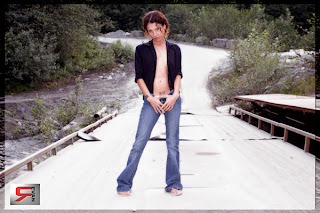
It was early - 3:20 a.m. early - when my alarm woke me. I dressed cozily and drove to the 108 Airport where Ministry of Forests and Range entomologist Leo Rankin was waiting for me.
He introduced me to air coordinator Don Wright and helicopter pilot Jay Camille; they were there, in these wee hours, to combat an invisible enemy: the spruce budworm.
"We'll be flying in the helicopter over the Air Tractors (planes) as they spray the forest," Rankin told me. "They'll be spraying BTK all around the South Cariboo today."
Then Camille shared his mandatory safety-spiel with me, which my sleep drenched brain didn't seem to absorb.
"So, in case of engine failure, it's imperative that you..." I just nodded, trying to keep my eyes open.
"All right, we're ready to take off," said Camille after showing me how to do up my seatbelt.
I climbed into the back of the helicopter, sitting next to Rankin. He helped
 me with the belt and talked about bugs while passing me my headset.
me with the belt and talked about bugs while passing me my headset.I learned the spruce budworm was more interested in Douglas firs than spruce around the local forests, eating the buds and needles of the coniferous foliage until they resembled something Charlie Brown would pick out for his Christmas tree.
"The budworm doesn't kill the trees immediately," said Rankin. "It weakens them so other pests, like the Douglas fir beetle, can take advantage."
By this time the rotor was in full spin, and my stomach lurched as we lifted off the ground. I took out my video camera and filmed our ascent into the still-dark sky.
We flew over the 108, and then over miles and miles of red trees. I thought the pine problem looked bad from the ground; it looked ten-fold worse from the air.
The pine beetle epidemic is over, said Rankin. "Virtually all of our mature pine is dead. That's why we have to protect what trees we have left."
We spotted one of the Air Tractors streaking BTK (the bacteria used to kill the budworm) over the woods near Alberta Lake.
Rankin said they must spray early as the product needs specific climate conditions to be affective.
We circled the plane so I could get good photos and footage of the spray; but the circling was starting to coax my breakfast back out.
"Do you have a good shot?" I heard Camille say in my headphones.
"Yes, thank you," I replied. The truth was I had no idea, but the helicopter had to steady or else my fellow passengers were going to see Cheerios all over the cabin.
I must have looked how I felt, because Rankin asked me if I was OK. Camille brought the copter down in a middle-of-nowhere forest, where ground coordinator Joan Westfall and her dog were waiting.
Westfall's job was to monitor the spray from the ground, checking weather readings every few minutes; she broke open some fir buds and showed me the munching menace this whole operation was about: a very tiny black worm.
The mosquitoes were horrendous, though. My face was so covered with bugs I felt like a bee-beard fellow I once saw on TV.
I didn't know what was worse: twirling about in a warm, cramped helicopter or being eaten alive by blood suckers.
But all too soon we were back in the air, heading back to the 108 to watch the planes reload and refuel.
"Now we'll be heading out for another round of spraying. You up for it?" Rankin asked me.
I made some excuse that I had enough information for my article and than
 ked the team for bringing me along.
ked the team for bringing me along.I would have stayed but my stomach and my skin just couldn't take another trip.


No comments:
Post a Comment